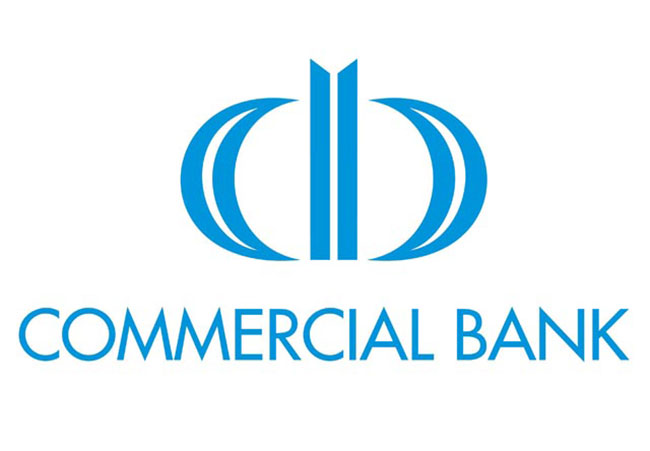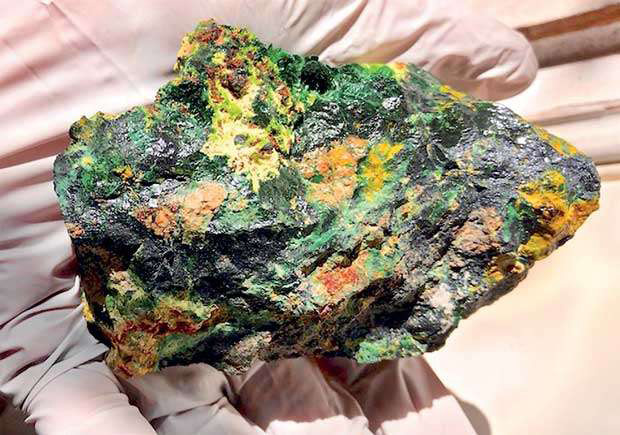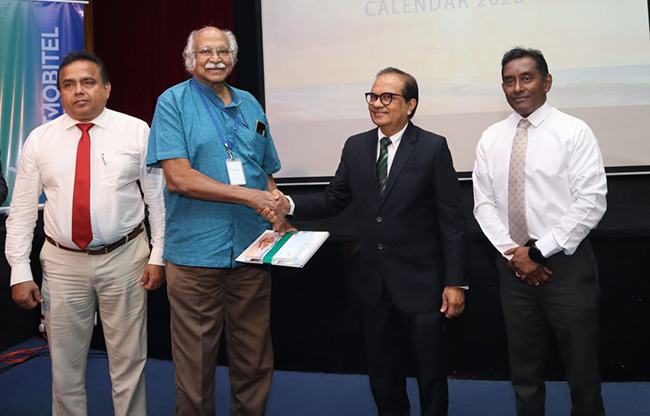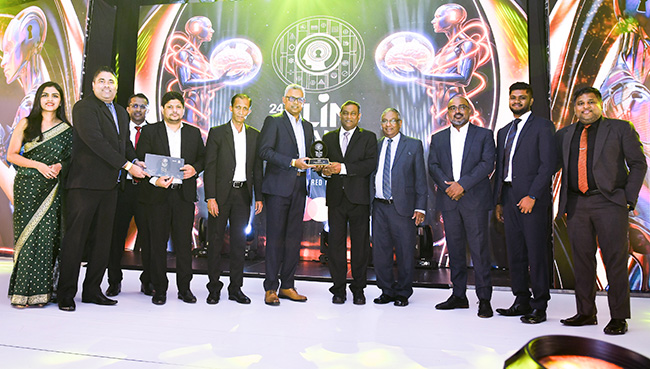Business
ComBank one of 10 ‘Most Admired Companies’ in Lanka for 4th consecutive year

The Commercial Bank of Ceylon has once again been included among the 10 ‘Most Admired Companies in Sri Lanka’ in the annual list compiled by the International Chamber of Commerce Sri Lanka (ICCSL) in collaboration with the Chartered Institute of Management Accountants (CIMA).
This is the fourth consecutive year that Sri Lanka’s biggest private sector bank has been ranked among the top 10 companies in this list, which was launched in 2018.
Commenting on this prestigious accolade, Commercial Bank Managing Director, S. Renganathan said: “The past year has been adverse for companies in general, but we believe it is how we have responded to the challenges of the pandemic and its impacts on our customers, that has earned us the admiration of the people. Our performance was achieved with an extremely balanced approach that considered the interests of all stakeholder groups, with an emphasis on those most vulnerable.”
Open to both listed and unlisted companies, the ICCSL-CIMA Most Admired Company Awards recognise entities that are a cut above the rest in terms of not just their financial performance but also the value they create for their shareholders, customers, employees, and the wider community in general. Commercial Bank was recognised as a company that inspires other organisations and entrepreneurs by proving its mettle with consistency, authority and sustainable growth, creating excellent business performance.
Ranked Sri Lanka’s Strongest Bank Brand in 2021 by Brand Finance, Commercial Bank of Ceylon ended 2020 with total assets of Rs 1.763 trillion, gross income of Rs 151.966 billion, net profit of Rs 16.373 billion, a deposits base of Rs 1.287 trillion and a loan book of Rs 961.859 billion. In the second quarter of 2021, the Bank had the distinction of becoming the first private bank in the country to have three key balance sheet indicators exceeding Rs 1 trillion, with total assets of Rs 1.935 trillion, total deposits of Rs 1.4 trillion and a loan book of Rs 1.034 trillion as at 30th June 2020.
One of the highlights of the Bank’s performance in 2020 was the confirmation by the Ministry of Finance that it was the biggest lender to Sri Lanka’s SME sector among all state-owned, private and specialised banks in the country, accounting for more than a fifth of all loans in terms of value and number. Commercial Bank lent Rs 163.98 billion or 21.57% of the Rs 759.7 billion in loans provided to SMEs by 19 institutions, while the 58,584 loans provided by the Bank represented 23.82% of the total of 245,883 loans granted in the pandemic-impacted year.
Commercial Bank was also the leader in providing financial relief, especially to SMEs, under the Government stimulus package during the first wave of the pandemic in 2020.
Another noteworthy recent milestone was the Bank’s achievement of carbon-neutral status, becoming the first Bank in Sri Lanka to have completely balance its environmental footprint.
The first Sri Lankan bank to be listed among the Top 1000 Banks of the World and the only Sri Lankan bank to be so listed for 11 years consecutively, Commercial Bank operates a network of 268 branches and 931 automated machines in Sri Lanka. The Bank’s overseas operations encompass Bangladesh, where the Bank operates 19 outlets; Myanmar, where it has a Microfinance company in Nay Pyi Taw; and the Maldives, where the Bank has a fully-fledged Tier I Bank with a majority stake.
Business
Unlocking Sri Lanka’s hidden wealth: A $2 billion mineral opportunity awaits

Sri Lanka stands on the brink of an economic transformation, powered not by traditional exports, but by the vast, untapped mineral wealth lying beneath its soil and off its shores. According to a comprehensive new business report launched by the Pathfinder Foundation in collaboration with the Australian Trade and Investment Commission, on 17th December in Colombo, the island’s mineral sector holds a staggering unrealised export potential of up to USD 2 billion.
Currently, Sri Lanka exports most of its high-purity minerals including world-renowned vein graphite, rare earth elements (REEs), and mineral sands in raw or semi-processed form, capturing only a fraction of their true value. The report reveals that while current exports to top destinations total about USD 389 million, the achievable potential is estimated at USD 778 million, with the full downstream value-add opportunity reaching several times that figure.
“Sri Lanka has great potential for exports,” stated Australian High Commissioner Matthew Duckworth at the report’s launch. “It is not only about mining but also about refining – moving up the value chain to get significantly higher export earnings.”
The nation is endowed with critical resources essential for global clean energy and high-tech supply chains. This includes an estimated 5 million tonnes of graphite (with purity up to 99.9%), over 600 million tonnes of mineral sands containing REEs like neodymium, and the massive Eppawala phosphate deposit, which alone holds 60 million tonnes of phosphate-bearing material. Experts believe even these numbers may be conservative due to a lack of island-wide surveys, pointing to major exploration opportunities.
However, realising this potential requires urgent action. The report identifies systemic barriers: a fragmented regulatory framework involving over 18 agencies, slow licensing, infrastructure gaps, and outdated mining methods. These challenges have discouraged investment and prevented value addition.
The path forward is clear. The government is already moving to modernise the approval process via a unified digital platform and is crafting a national critical minerals strategy. The report emphasises that success hinges on attracting foreign expertise and investment, particularly in downstream processing – turning graphite into battery-grade material, refining rare earths, and processing mineral sands domestically.
Australia, with its global leadership in sustainable mining and technology, is positioned as a key partner. Australian METS (Mining Equipment, Technology, and Services) companies can bring advanced technology, ESG-compliant practices, and training, potentially reducing operational costs by 30-40% while improving recovery rates.
“For Sri Lanka, the stakes are high. Developing a modern, sustainable mineral sector can diversify the economy, create high-value jobs, build resilience, and integrate the nation into strategic global supply chains,” the Australian High Commissioner noted. The message from the report is one of urgent optimism: the resources are here, the international partners are ready, and the roadmap is laid out. Now is the time for policymakers, investors, and stakeholders to come together to unlock this buried treasure for the benefit of all Sri Lankans.
By Sanath Nanayakkare
Business
Environmental damage now a direct threat to telecom operations, SLT chief warns at 2026 calendar launch

Environmental destruction is no longer an abstract environmental concern but a direct business risk, Sri Lanka Telecom/Mobitel Chairman Dr. Mothilal de Silva warned, as the national telecom giant launched its 2026 corporate calendar linking climate change, marine degradation and network stability.
Unveiling the calendar, Dr. de Silva said the initiative was not a ceremonial exercise but a corporate statement on responsibility and survival. “Today we are not just unveiling a calendar; we are sharing a story — a story of beauty, resilience and profound responsibility,” he said, stressing that environmental protection had become business-integral for SLT.
The 2026 SLT-Mobitel desk and digital calendar takes viewers beneath Sri Lanka’s seas, focusing on the intricate forms of marine shells and clams. Created by renowned artists Pulasthi Ediriweera and Nalin Jayarathna, the artworks portray seashells as both natural marvels of design and lasting symbols of fragile marine life.
“Each shell is a protective home — a permanent memorabilia left by gentle creatures,” Dr. de Silva said. “In their form and pattern, they send us a silent message about their presence and their urgent need for protection.”
Drawing a direct link between ecological degradation and recent climate-related disasters, Dr. de Silva rejected attempts to mask environmental realities. “You cannot cover this up with fake news. The destruction of forests, hill-country ecosystems, tea estates and irresponsible land use has created these calamities,” he said, referring to recent cyclonic events and flooding.
He warned that climate change and rising sea levels were already affecting SLT’s core infrastructure. Sri Lanka’s international connectivity depends on five subsea communication cables landing in Colombo and Matara. “Unusual sea-level rise and abnormal tides have already caused network outages. When the sea is disturbed, it directly affects the quality and reliability of our network,” he said.
Dr. de Silva said SLT and its international consortium partners follow strict environmental safeguards when laying, maintaining and even disposing of subsea cables. These include detailed environmental surveys, route planning to avoid sensitive marine ecosystems and specialised installation techniques. Cable repair operations based in Galle, he added, also adhere to stringent environmental standards.
“Our work is fundamentally about connection — connecting people, businesses and nations. But this connection must be built with care for the environment that hosts it,” he said, noting that sustainability was not merely a corporate social responsibility obligation but essential to business continuity.
Marine naturalist Dr. Malik Fernando, addressing the launch, highlighted Sri Lanka’s rich but inadequately studied seashell diversity. He said several marine and freshwater mollusc species were protected under existing laws, yet continued to appear in markets due to weak enforcement.
Some shells, including cone shells, are highly venomous and capable of causing human fatalities, Dr. Fernando noted, underscoring the risks posed by unregulated collection. While many mollusc species are widely dispersed due to larval movement, he said certain rare species recorded from limited locations could be near-endemic and vulnerable to extinction.
Dr. Fernando also pointed to the broader challenge of biodiversity research, noting that many species remain unidentified due to the lack of systematic field studies, despite improved access to global scientific resources through digital platforms.
In concluding remarks, Dr. de Silva called on the media to play a responsible role in conveying environmental truths to the public and suggested that the calendar be shared internationally, including at future UN climate conferences. “A digitally empowered Sri Lanka must go hand in hand with preserving its natural wonders,” he said. “This calendar is a reminder that protecting the environment is not optional — it is essential for our future.”
By Ifham Nizam
Business
Tokyo Cement Group honoured for impactful CSR at SLIM Brand Excellence 2025

Tokyo Cement Group’s longstanding commitment to social progress and sustainability was honoured with a CSR Brand of the Year Merit Award at the SLIM Brand Excellence 2025 Awards ceremony held recently. The accolade recognises the Group’s flagship environmental conservation and community empowerment initiatives, designed to drive national transformation through meaningful, measurable CSR initiatives.
The Tokyo Cement led environmental stewardship programmes appraised by the award includes mangrove restoration, forest plant nurseries, coral reef rehabilitation, and marine biodiversity conservation projects, aimed at creating a sustainable and greener future. Through decades of collaborative engagement with expert project partners Tokyo Cement has delivered remarkable milestones in each focus area. This includes planting nearly 100,000 mangrove saplings along the Northern and Eastern coastlines and supplying over 116,000 forest trees nurtured at its own nurseries. The company’s Coral Reef Rehabilitation project, which upcycles ready-mixed concrete waste, has deployed more than 1,000 Reef Balls that act as artificial reef substrates at critical reef restoration sites around the island.
Among Tokyo Cement’s most influential sustainability initiatives is its Renewable Energy Programme that makes its entire local manufacturing process 100% energy independent through an installed capacity of 24MW. With the support of nearly 2,500 farming families across the Mahiyangana, Badulla, Monaragala, Trincomalee, Kilinochchi, and Jaffna districts, who have helped plant more than 10 million Gliricidia trees, the company plays a key role in mobilising the country’s rural economy.
-

 Features5 days ago
Features5 days agoWhy Sri Lanka Still Has No Doppler Radar – and Who Should Be Held Accountable
-

 News1 day ago
News1 day agoPakistan hands over 200 tonnes of humanitarian aid to Lanka
-

 Midweek Review2 days ago
Midweek Review2 days agoHow massive Akuregoda defence complex was built with proceeds from sale of Galle Face land to Shangri-La
-

 News1 day ago
News1 day agoPope fires broadside: ‘The Holy See won’t be a silent bystander to the grave disparities, injustices, and fundamental human rights violations’
-

 Latest News5 days ago
Latest News5 days agoLandslide early warnings in force in the Districts of Badulla, Kandy, Kegalle, Kurunegala, Matale, Nuwara Eliya and Ratnapura
-

 News6 days ago
News6 days agoGovt. okays postgraduate medical training for Maldivian medical officers and dental surgeons
-

 Features5 days ago
Features5 days agoSrima Dissanayake runs for president and I get sidelined in the UNP
-

 Editorial5 days ago
Editorial5 days agoDisaster relief and shocking allegations













